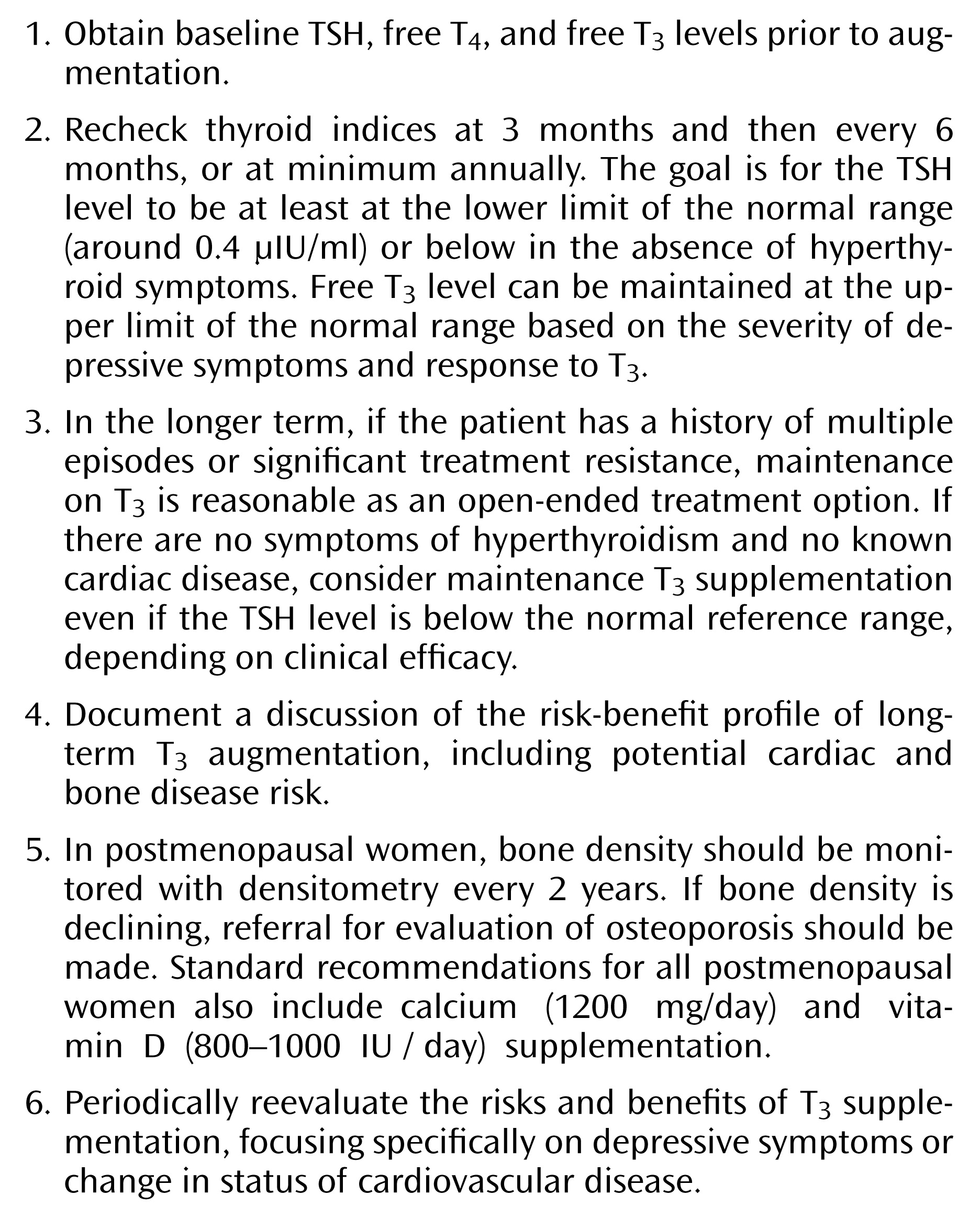T3 in Conjunction With Tricyclic Antidepressants
Augmentation of antidepressants with T
3 is one of the oldest evidence-based treatments for major depressive disorder. In 1969, Prange et al. conducted a pivotal study (
8) demonstrating that administration of liothyronine enhanced response to tricyclic antidepressants in patients with treatment-resistant depression. Thyroid function was monitored, but methods available at that time were not sensitive or specific. Based on ankle jerk reflexes and protein-bound iodine assays, patients in the study appeared to have elevated thyroid function after treatment. Many subsequent studies have confirmed the Prange et al. study's finding of efficacy, but few have formally assessed the HPT axis during treatment.
The majority of the evidence base for use of T
3 is for its coadministration with tricyclics. Two meta-analyses of T
3 coadministration with tricyclics have been published, one reviewing acceleration trials (
9) and the other augmentation trials (
10). Acceleration is defined as the use of T
3 at commencement of antidepressant treatment to enhance and hasten response. Augmentation is the administration of T
3 in patients who are unresponsive or partially responsive to an adequate course of antidepressant treatment initiated previously.
Acceleration of antidepressant response with T3.
A meta-analysis by Altshuler et al. (
9) of six double-blind, placebo-controlled studies (125 patients total) of T
3 acceleration of tricyclics was positive. By definition, these were short-term studies of 2 to 3 weeks, and none discussed the option of continuing T
3 once antidepressant response was achieved. In addition, many were conducted before the advent of more sensitive assays of thyroid functioning in the late 1980s. Three of these acceleration studies (
11–
13) obtained initial lab values of protein-bound iodine and looked at ankle jerk reflexes and serum T
4 binding, but none performed follow-up testing. No differences in baseline thyroid tests were found between patients who responded to T
3 and those who did not, but some authors speculated that there may have been subtle thyroid dysfunction in the responders that was undetectable by the assays. In addition, a significant gender effect was observed, with women responding more robustly than men. While women generally have been found to have higher rates of both comorbid depressive syndromes and thyroid disease, a consistent association has not been replicated.
Augmentation of antidepressant response with T3.
Aronson et al. (
10) conducted a positive meta-analysis of T
3 augmentation of tricyclics, finding eight controlled clinical studies with 292 patients. The studies were up to 12 weeks long, and several performed baseline and follow-up modern thyroid assays (
4,
14–
16). One positive study in 1977 conducted initial thyroid screening and additionally tested the CSF monoamine metabolites 5-hydroxyindoleacetic acid and homovanillic acid, hypothesizing that the mechanism of treatment with T
3 was an increase of available monoamines (
17). However, the study found no differences in CSF monoamine metabolites between the placebo and active T
3 groups or between responders and nonresponders to T
3.
Thase et al. (
14) found no association between results of thyroid function tests or TRH stimulation testing at baseline and outcome in a subset of patients treated with T
3. Joffe and Singer (
4) evaluated T
3 versus T
4 in a randomized trial and found significant changes after 3 weeks in T
3, T
4, free T
4, TSH, and T
3 resin uptake in both groups, but these changes were not positive predictors of response; the main finding was that T
3 was more effective than T
4 as an augmenter. A 2-week augmentation study of lithium and T
3 (
15) found in 1993 that the two were equally effective and outperformed placebo, with baseline TSH documented as being within normal range.
T3 in Conjunction With SSRIs
Recently a number of studies have examined the augmentation of selective serotonin reuptake inhibitors (SSRIs) with thyroid hormone, but the data are more limited than with tricyclics. A review by Cooper-Kazaz and Lerer (
18) found that not enough data were available yet for a meta-analysis but that a positive trend was revealed when the available double- and single-blind studies were analyzed. Papakostas et al. (
19) reported a negative meta-analysis using strict inclusion criteria and finding only three adequate double-blind, randomized, placebo-controlled studies. The Sequenced Treatment Alternatives to Relieve Depression (STAR*D) study (
20) evaluated SSRI augmentation using either lithium or T
3 and found no statistical difference in efficacy between the treatments, but T
3 had superior tolerability and adherence. All of these studies were short term, with the longest (STAR*D) lasting 12 weeks.
Two studies of T
3 in combination with SSRIs included baseline and follow-up thyroid testing. In the first, Cooper-Kazaz et al. (
21) compared sertraline (50–100 mg) combined with either T
3 (25–35 μg) or placebo in an 8-week study and found that the sertraline-T
3 combination produced superior response and remission rates. After 8 weeks of T
3 supplementation, the mean TSH level fell significantly from 1.70 μIU/ml at baseline to 0.28 μIU/ml in responders, whereas nonresponders had mean pre- and posttreatment levels of 1.88 μIU/ml and 0.76 μIU/ml, respectively; responsiveness to treatment was significantly correlated (p=0.01) with the change in TSH level, suggesting that the therapeutic benefit could have been due to changes in the thyroid axis in this population. In a post hoc analysis, baseline T
3 levels in patients who responded to T
3 augmentation were significantly lower than in those who did not respond (107.60 ng/dl compared with 137.4 ng/dl, p=0.002). There was also a small but significant decline in TSH levels in the placebo group.
A combination study by Appelhof et al. (
22) in which 124 patients were randomly assigned to receive paroxetine combined with 25 μg of T
3, 50 μg of T
3, or placebo showed a statistically significant dose-dependent increase of T
3 levels along with lowered T
4 (the final T
4 levels after 8 weeks of treatment were 0.9 pmol/liter in the placebo group, 0.6 pmol/liter in the 25-μg T
3 group, and 0.4 pmol/liter in the 50-μg T
3 group). Significant changes in thyroid function on testing were associated with significant side effects in nine of 28 patients in the 50-μg group, including sweating, tremor, nervousness, and palpitations, but there were no significant differences between the 25-μg T
3 and placebo groups. It is possible that noradrenergic effects of paroxetine due to norepinephrine transporter blockade exacerbated somatic symptoms that were consistent with a hyperthyroid state. Efficacy outcome was negative, with no differences between placebo and the two T
3 groups.
While T
3 compared well with lithium in STAR*D (
20), and results with T
3 as an augmentation or combination strategy are encouraging, more controlled trials are needed to fully determine the efficacy of T
3 in combination with SSRIs.


